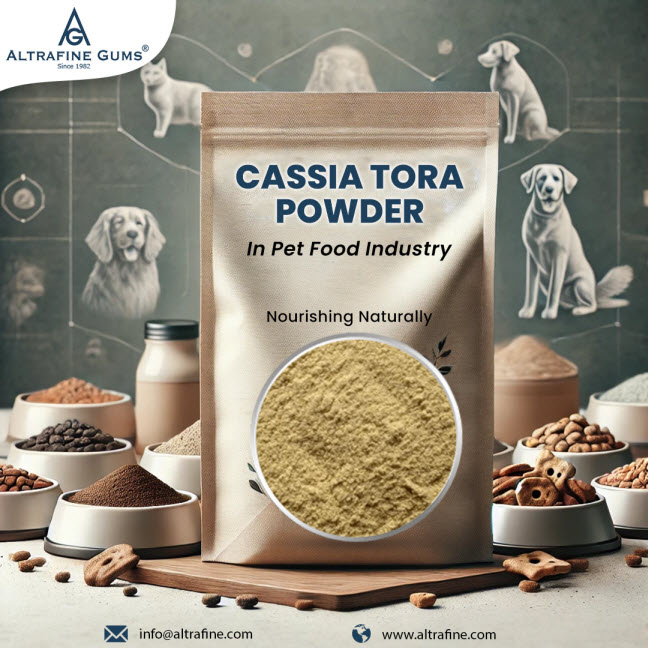
Cassia Gum: The Ideal Gelling and Thickening Agent for Pet Food, Feed, and Food Industries
Table of Contents
Cassia gum, a natural polysaccharide derived from the endosperm of the seeds of the Cassia tora and Cassia obtusifolia plants, has gained significant recognition for its versatile applications in various industries.
One of its most important uses is as a gelling and thickening agent in the pet food, animal feed, and human food sectors. This article explores the unique properties, benefits, and applications of cassia gum in these industries, ensuring that it remains the core keyword throughout.
What is Cassia Gum?
Cassia gum is a natural, plant-based ingredient primarily composed of galactomannan, a type of polysaccharide. It is derived from the seeds of Cassia tora and Cassia obtusifolia through a series of processes, including dehusking, extraction, and purification.
The result is a fine cassia gum powder that exhibits excellent thickening, gelling, and stabilizing properties, making it an ideal choice for food and feed applications.
Key Properties of Cassia Gum
- Gelling Agent: Cassia gum forms gels when combined with other hydrocolloids such as xanthan gum or carrageenan, which enhances its functionality in various formulations.
- Thickening Agent: Its ability to increase the viscosity of solutions makes it an effective thickening agent in food and feed products.
- Stabilizing Agent: It helps maintain the consistency and quality of products during storage and use.
- Eco-Friendly: Being a natural, plant-derived product, cassia gum is sustainable and biodegradable.
Applications of Cassia Gum in the Pet Food Industry
Cassia gum is extensively used in pet food production due to its unique characteristics. Pet food manufacturers prioritize ingredients that enhance the texture, appearance, and shelf life of their products, making cassia gum an indispensable component.
How Cassia Gum Benefits Pet Food
- Improves Texture and Palatability: Cassia gum enhances the texture of wet pet foods, making them more appealing to pets.
- Moisture Retention: It helps retain moisture in canned and packaged pet food, preventing them from drying out.
- Stabilizes Formulations: The gelling and thickening properties of cassia gum ensure uniform consistency, even in complex formulations.
- Safe for Animals: Cassia gum is non-toxic and meets regulatory standards for animal feed ingredients.
Popular Applications in Pet Food
- Wet Pet Foods: Cassia gum is widely used in wet pet food recipes for dogs and cats, providing a smooth, gel-like texture.
- Treats and Chews: Its thickening properties are used to create chewy, firm treats that pets enjoy.
- Nutritional Supplements: Cassia gum stabilizes liquid supplements or medicinal syrups for pets.

Applications of Cassia Gum in the Animal Feed Industry
In the animal feed industry, cassia gum plays a crucial role in improving feed quality and production efficiency. It acts as a binding and thickening agent that enhances feed consistency and ensures uniform distribution of nutrients.
How Cassia Gum Benefits Animal Feed
- Binding Agent: Cassia gum binds feed particles together, reducing dust and improving pellet quality.
- Water Absorption: Its water-absorbing capacity ensures that the feed remains moist and palatable.
- Improved Digestibility: By stabilizing the feed structure, cassia gum can contribute to better digestion and nutrient absorption in animals.
Common Uses in Animal Feed
- Livestock Feed Pellets: Cassia gum is used to enhance the stability and durability of pellets.
- Aquaculture Feed: It is utilized in fish and shrimp feed to improve water stability and prevent disintegration.
- Supplementation: Cassia gum can stabilize feed supplements or additives.
Applications of Cassia Gum in the Food Industry
The human food industry extensively utilizes cassia gum as a gelling and thickening agent in various products. Its ability to create desirable textures and improve stability makes it a preferred choice for food manufacturers.
How Cassia Gum Benefits Food Products
- Improves Texture: Cassia gum is used to achieve a smooth and creamy texture in processed foods.
- Stabilizes Products: It prevents ingredient separation, ensuring consistency and homogeneity.
- Enhances Shelf Life: The thickening and gelling properties help maintain product quality over time.
Common Applications in Food Products
- Dairy Products: Cassia gum is used in ice creams, yogurts, and cheese spreads to improve texture and stability.
- Bakery Products: It acts as a stabilizer and thickener in fillings, glazes, and icings.
- Confectionery: Cassia gum enhances the gel-like consistency in gummy candies and desserts.
- Processed Foods: It is used in soups, sauces, and canned foods for thickening and stabilizing purposes.
Advantages of Using Cassia Gum
- Cost-Effective: Cassia gum is more affordable compared to other gelling agents like guar gum and locust bean gum.
- Versatile: It is compatible with various ingredients and processes, making it suitable for a wide range of applications.
- Eco-Friendly: Being derived from plants, cassia gum is a sustainable choice for manufacturers.
- Safe and Approved: Cassia gum meets global food and feed safety standards, including those set by the FDA and EFSA.
FAQs About Cassia Gum
1. What makes cassia gum an effective gelling agent?
Cassia gum forms gels when combined with other hydrocolloids like xanthan gum or carrageenan. Its galactomannan structure provides the necessary viscosity and elasticity for creating stable gels.
2. Is cassia gum safe for pets and humans?
Yes, cassia gum is considered safe for both pets and humans. It is non-toxic, non-allergenic, and meets stringent safety standards for food and feed products.
3. How is cassia gum different from guar gum?
While both are galactomannan-based thickeners, cassia gum offers stronger gelling properties when combined with other hydrocolloids. It is also more cost-effective and provides unique textural benefits.
4. Can cassia gum be used in gluten-free products?
Yes, cassia gum is gluten-free and is commonly used as a stabilizer and thickener in gluten-free food formulations.
5. What are the regulatory approvals for cassia gum?
Cassia gum is approved for use in food and feed products by several international regulatory bodies, including the FDA, EFSA, and JECFA.
6. Is cassia gum eco-friendly?
Yes, cassia gum is plant-derived, sustainable, and biodegradable, making it an environmentally friendly choice.
7. How does cassia gum improve pet food quality?
Cassia gum enhances the texture, moisture retention, and stability of pet food, ensuring a consistent and appealing product for pets.
8. Can cassia gum be used in liquid food products?
Yes, cassia gum can stabilize and thicken liquid products like soups, sauces, and dairy-based beverages.
Conclusion
Cassia gum is a remarkable natural ingredient that has transformed the pet food, animal feed, and human food industries. Its exceptional gelling and thickening properties make it a go-to choice for manufacturers seeking to improve the quality, texture, and stability of their products.
Whether it’s ensuring the palatability of wet pet food, enhancing the durability of feed pellets, or creating creamy textures in dairy products, cassia gum continues to prove its versatility and value.
By integrating cassia gum into your formulations, you not only enhance the quality of your products but also contribute to a sustainable and eco-friendly approach to food and feed production.






